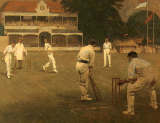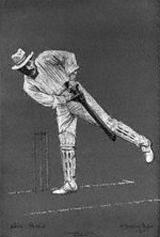A Canterbury tale
Martin Williamson traces the history of one of the games most enduring pieces of art
Martin Williamson
10-Dec-2005
|
|

|
The announcement last month that Kent are going to sell one of cricket's most famous paintings - Kent v Lancashire by Albert Chevallier Tayler - raised more than a few objections. While the estimated price tag - £500,000 - would pay for an overseas pro or two for the rest of the decade, the timing could have been better - 2006 is the centenary of the match depicted. And the painting remains in demand for use on a variety of items ranging from greetings cards - the copyrighters have granted five such licences in the last four years alone - to chocolate boxes and books.
The original has been on loan to the MCC since 1999 and is hanging in the pavilion at Lord's; before that, it was hung in the pavilion at Canterbury itself, and a copy still remains there today. But how did one of the game's most enduring pieces of art come about?
The commission for the original was given to Tayler in the autumn of 1906 after Kent had secured their first county title of the modern era. That autumn, the celebrations of the victory continued almost unabated. On October 11, the county's members gave a dinner in honour of the players in London. During his speech, Lord Harris, the county chairman, suggested that the members might consider commissioning a painting from Tayler - not a posed reproduction of the XI, but an action shot. Harris made two conditions. One was that the ground had to be Canterbury, the other that the bowler had to be Colin Blythe. Although Blythe had taken 111 wickets at 19.90, it was his least successful season in the 13 he played before his premature death in the Great War. But he and his wickets had done so much to lift Kent from the good to the excellent in the early days of the twentieth century.
Tayler, at the time aged 44, was a safe choice. A graduate of the Slade School, he later became a full member of the Royal Academy of Art. He was an enthusiastic cricketer, and in 1905, he had produced a series of 100 lithographs of the leading players of the era based on the revolutionary photography of George Beldam. His painting of the 1886 Eton-Harrow match still hangs in the Long Room at Lord's. A fee of 200 guineas (£210) was agreed between Tayler and Kent, with additional reproduction rights taking that to a possible 350 guineas (£367.50).
The stipulation that the match had to be at Canterbury limited the choice considerably as there had only been three games there that summer - two in the festival week in early August and one at the end of the month. All three matches had been memorable, but against Lancashire, Blythe had taken eight wickets, and so that was the one chosen. It also turned out to be fitting as in his career, Blythe took almost twice as many wickets there (281) as he did anywhere else.
|
|

|
Tayler decided that he would base the painting on the hour before lunch on the second day, August 10, when Blythe and Arthur Fielder were bowling Lancashire towards an innings defeat. The conundrum the artist faced was to get close enough to the action for it not to appear as a spec on a large green expanse, but also to include all 11 Kent players. That he did by cleverly compressing the overall field. The end result is that the viewer is far closer to the action than he would be if he was situated on the boundary.
To ensure accuracy of the facial detail, Tayler arranged sittings with all the Kent side, but struggled to do so with Harry Makepeace, the Lancashire batsman he wanted at the non-striker's end. That resulted in his only major compromise - Tayler made the non-striker William Findlay. Findlay had retired from Lancashire at the end of 1906, but as the new Surrey secretary, Tayler's London studio was easily accessible. The only problem was that he had not played in the match concerned.
Tayler painted the scene from the Nackington Road End of the St Lawrence ground with Canterbury Cathedral in the background. In it, Blythe, in front of the newly-completed pavilion, bowled to England and Lancashire batsman Johnny Tyldesley.
Tayler's painting was finished towards the end of the 1907 season, by which time 192 engravings had been pre-ordered - providing more than enough income to pay all the artist's fees before Kent had even taken delivery of the original. Very soon, the painting's popularity meant that it has been loaned for display at Blackheath - then a major ground for Kent cricket - and then, for a short time, at Lord's, before returning to Canterbury, where it stayed for the next 90 years.
After the initial limited-edition print in 1908 (signed by Tayler and Lord Harris), the next reprint did not go on sale until 1990, when it was signed by EW Swanton, Colin Cowdrey and Les Ames and cost £150. In 2000, a limited run of 100 prints to commemorate the millennium were sold, signed by Swanton, Cowdrey and Matthew Fleming.
Tayler's paintings in general have survived as a colourful reminder of the colour and pageantry of the late Victorian and Edwardian era. His image of Canterbury is possibly the most evocative vignette of cricket's Golden Age.
Is there an incident from the past you would like to know more about? E-mail us with your comments and suggestions.
Bibliography
Colin Blythe - Lament For A Legend - Christopher Scoble (SportsBooks Ltd 2005)
The Cricketer -Various
Colin Blythe - Lament For A Legend - Christopher Scoble (SportsBooks Ltd 2005)
The Cricketer -Various
Martin Williamson is managing editor of Cricinfo